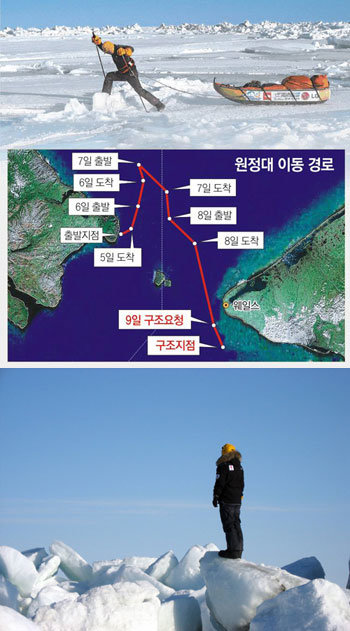With Only 27 Kilometers to Go

I dont have any regrets since I gave my best. I will humbly accept what Mother Nature denied me and, using this failure as a stepping stone, will try again.
The voice of expedition leader Park Young-seok (44, director at Goldwin Korea, former member of the mountaineering club of Dongguk University) was so strong that it was difficult to imagine that it was coming from someone who had just been rescued from the point of death.
The Bering Strait Expedition (sponsored by the Dong-A Ilbo, LG, and The North Face), led by Park had to call an end to their expedition on March 9 due to floating ice moving at fast speeds, pushed by strong winds.
The Bering Strait Expedition consisted of three members: leader Park, Oh Hee-joon (37, alpine team, North Face), and Lee Hyung-mo (28, former member of mountaineering club at Kwandong University). The expedition was rescued by a U.S. helicopter at a point 27 kilometers from the Seward Peninsula of Alaska at 65° 18 30 north latitude and 168° 19 26 west longitude, on March 9, 7:05 a.m. (Korean time), and safely arrived at the nearby town of Nome.
Three days, 21 hours, and 30 minutes had passed since the team left Uelen, Chukotka, Russia (at 66° 1 north latitude and 169° 38 west longitude) on March 5 at 9:35 a.m. (12:35 p.m. local time). The teams goal had been to arrive in Wales (at 65° 35 north latitude and 168° west longitude), a seaside village in Alaska 88 kilometers from the point of departure, on March 19.
The expedition faced dangerous situations such as encountering a gigantic whale at a distance of 20 meters and polar bears, along with freezing temperatures of 30 degrees Celsius below zero or lower, but continued with the expedition, walking 10 kilometers in five hours on the first day.
However, nature in the form of strong winds was too great an adversary. Southerly winds blew during the first two days of the expedition and, combining forces with northern currents, caused ice sheets to move north at speeds of up to three kilometers per hour. When the team woke up in the morning, they would have been floating toward the Arctic Ocean.
On March 7, the third day of the expedition, the wind changed to northwesterly winds, and the floating ice consequently changed direction southwest, causing hopes to rise for the expedition, which was moving east. However, the strong winds were still a problem. Winds moving at speeds of 20 meters per second or higher (stronger than typhoons, which begin at 17 meters per second) continued to push the ice at 5.8 kilometers per hour. The expeditions walking speed could not keep up, and they ended up moving toward the Pacific Ocean. They had no choice but to call for a rescue team. The ice sheet that the expedition was on floated an astonishing 50 kilometers during a single night on March 8, the day before they were rescued.
The Bering Strait is an extremely difficult course due to unpredictable currents and strong winds, and efforts to cross it on foot have succeeded only twice in the history of mankind.
Leader Park Young-seok selected the Bering Strait as his next challenge after achieving the Adventure Grand Slam (climbing the 14 highest 8000m+ Himalayan peaks, the seven highest peaks on each continent, and the three poles of Everest, the North Pole, and the South Pole) in 2005, and prepared for the expedition for nearly two years. Major international news media outlets such as the AP reported from Anchorage, Alaska on the expeditions Bering Strait crossing challenge and rescue.
The team, including leader Park, which is planning on giving the Bering Strait another try, will return to Korea around March 15, and leave for Nepal on March 31 to find a new path up the southwest ridge of Everest (8850 meters above sea-level), the highest peak in the world.
jeon@donga.com







